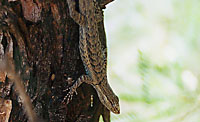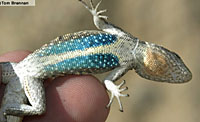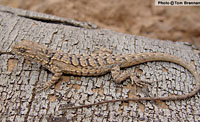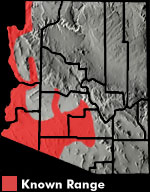Online Field Guide to The Reptiles and Amphibians of Arizona



Maricopa County, AZ
 Yuma Co., AZ |
||
 Yuma Co., AZ |
| LONG-TAILED BRUSH LIZARD Urosaurus graciosus | |
|
DESCRIPTION: A small (up to 66 mm or 2.6″ from snout to vent), slim, pale gray or tan lizard with a very long (up to twice the length of the body), thin tail. Body markings are variable but usually consist of muted, gray-brown, irregularly-shaped blotches or crossbars. Markings are very faint or absent on some specimens. The throat is usually yellow or orange. A single, wide, lengthwise strip of enlarged, keeled scales runs down the middle of the back. The remainder of the dorsal scales are small and granular. The scales on the tail and limbs are enlarged and keeled. A fold of skin runs along each lower side of the body. Males have two large, blue to blue-green patches marked with white flecks on the belly. Belly patches are lacking in females. Its single, wide strip of enlarged, keeled scales on the back and its long tail distinguish this lizard from the similar Ornate Tree Lizard. HABITAT: Primarily an inhabitant of the Lower Colorado River Sonoran Desertscrub community and Mohave Desertscrub. It also follows riparian corridors and drainages into Arizona Upland Sonoran Desertscrub. It can be a common sight in creosotebush-lined desert flats with sandy soil and along tree lined drainages. BEHAVIOR: An excellent climber, this diurnal lizard is commonly seen basking and foraging on the branches of creosotebushes and trees. When threatened it often aligns itself with a branch and remains motionless relying on its cryptic coloration to avoid detection. It often seeks shelter in the sand or in a burrow on cool nights but may sleep in the branches after a particularly hot day. DIET: The Long-tailed Brush Lizard eats a variety of insects, spiders, and occasionally some plant material. REPRODUCTION: This lizard lays one or two clutches of eggs in spring or summer. Clutch size ranges from 2 to 10 eggs. By Thomas C. Brennan Brennan, T. C., & A. T. Holycross. 2006. A Field Guide to Amphibians and Reptiles in Arizona. Arizona Game and Fish Department. Phoenix, AZ Brennan, T. C., & A. T. Holycross. 2005. A Field Guide to Amphibians and Reptiles of Maricopa County. Arizona Game and Fish Department. Phoenix, AZ Stebbins, R.C. 2003. A Field Guide to Western Reptiles and Amphibians, Third Edition. Houghton Mifflin Company, Boston, MA. |
|
Visit Partners in Amphibian and Reptile Conservation:


HOME
Copyright © 2023, Arizona Game and Fish Department. All rights reserved.
If you make use of the textual contents of this site in reports, publications, etc. please cite and credit the author(s) and photographer(s). All photos on this website are copyrighted. However, those found in the species account section may be used for any noncommercial scientific, educational, or conservation purposes provided that photographs are not altered and continue to bear the copyright symbol and name of the photographer. Please contact the photographer regarding commercial use of copyrighted photographs.












